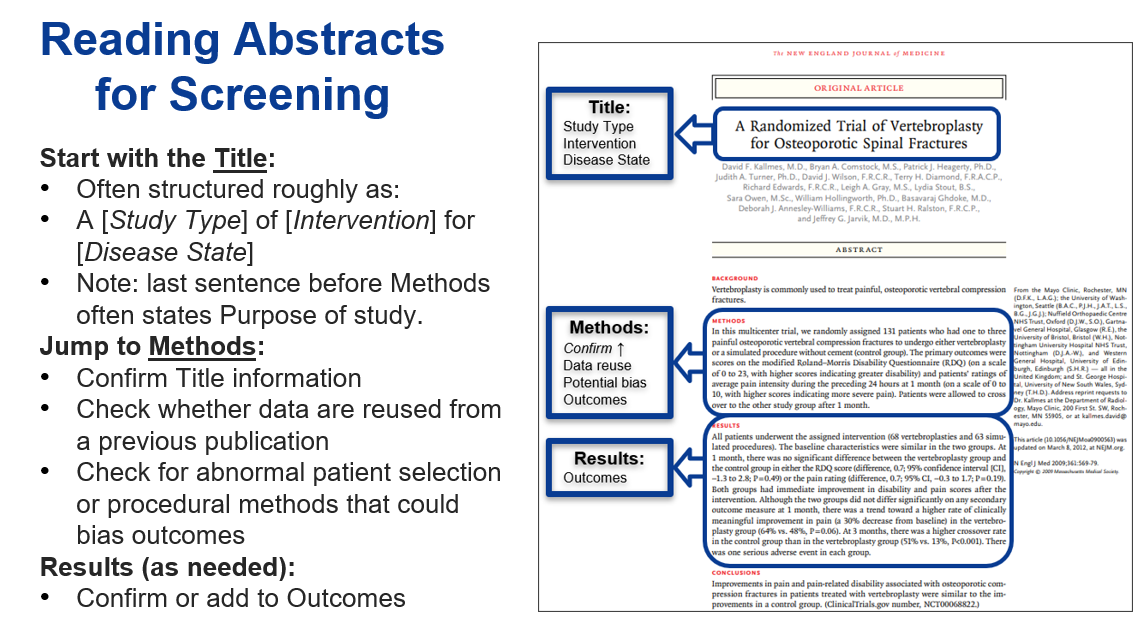Table of Contents
Selecting Your Studies (Screening)
After running your search through one or more databases, the next step is to screen through the results to decide which studies you want to include.
Selecting Exclusion Criteria
Exclusion criteria should be determined before screening begins. Common exclusion reasons include the following:
- Publications prior to a specific date (for instance, January 1, 2000)
- Articles not written in English
- The wrong type of article (meta-analysis/systematic review, editorial, correspondence, letter to the editor, abstracts, protocol)
- The wrong type of study (in vitro and in vivo studies, retrospective study, cohort study, case series, case study)
- Too few patients (for example, fewer than 10).
Additional exclusion criteria often relate to PICO. The study under consideration may involve the wrong population, interventions, comparators, and outcomes.
Screening Steps
* Before going through each study, begin by removing any duplicates with the Nested Knowledge software.
* When reading the title and abstract to determine whether a study should be included, check each of the inclusion and exclusion criteria and the elements of PICO. If there are not enough details in the abstract, mark this study for full-text review. For studies that don’t meet the inclusion criteria, mark them as excluded and note the reason they were excluded. Be sure to note any recurring exclusion reasons that were not determined beforehand.
* After the initial round of screening is complete, go back through the remaining included studies and locate the full text for each. A great resource for finding full text is Sci-Hub.
* When looking through a PDF of a study, use “Ctrl F” to find specific words or phrases to quickly locate the elements of PICO to quickly find essential information. The remaining included studies will go on to have their data tagged and extracted for analysis.
See the visual here for an overview of where to find screening-related information in underlying studies:

Should You Exclude Follow-up Studies?
It is generally better to include the primary study over follow-up (or post-hoc) studies. However, there are times when the follow-up study is more relevant than the primary study. As long as you are only collecting data on each patient once, the follow-up study should be included.
Is Dual Screening Necessary?
Dual screening is a process where two reviewers independently screen the search results to make decisions about whether to include or exclude articles. Discrepancies are usually discussed before a final decision is made. Although dual screening may take more time, several studies have documented its advantage. 1 2 3
One study showed that single-reviewer abstract screening missed 13% of relevant studies, while dual-reviewer screening missed only 3%.1 Another analysis found a total reviewer error rate (false inclusion and false exclusion) of 10.76%.2 The choice of whether to dual-screen or not should be discussed by the team.
This article provides some alternatives to dual screening.
References
- Gartlehner G, Affengruber L, Titscher V, Noel-Storr A, Dooley G, Ballarini N, König F. Single-reviewer abstract screening missed 13 percent of relevant studies: a crowd-based, randomized controlled trial. J Clin Epidemiol. 2020 May;121:20-28. doi: 10.1016/j.jclinepi.2020.01.005. Epub 2020 Jan 21. PMID: 31972274.
- Wang Z, Nayfeh T, Tetzlaff J, O'Blenis P, Murad MH. Error rates of human reviewers during abstract screening in systematic reviews. PLoS One. 2020 Jan 14;15(1):e0227742. doi: 10.1371/journal.pone.0227742. PMID: 31935267; PMCID: PMC6959565.
- Waffenschmidt S, Knelangen M, Sieben W, Bühn S, Pieper D. Single screening versus conventional double screening for study selection in systematic reviews: a methodological systematic review. BMC Med Res Methodol. 2019 Jun 28;19(1):132. doi: 10.1186/s12874-019-0782-0. PMID: 31253092; PMCID: PMC6599339.